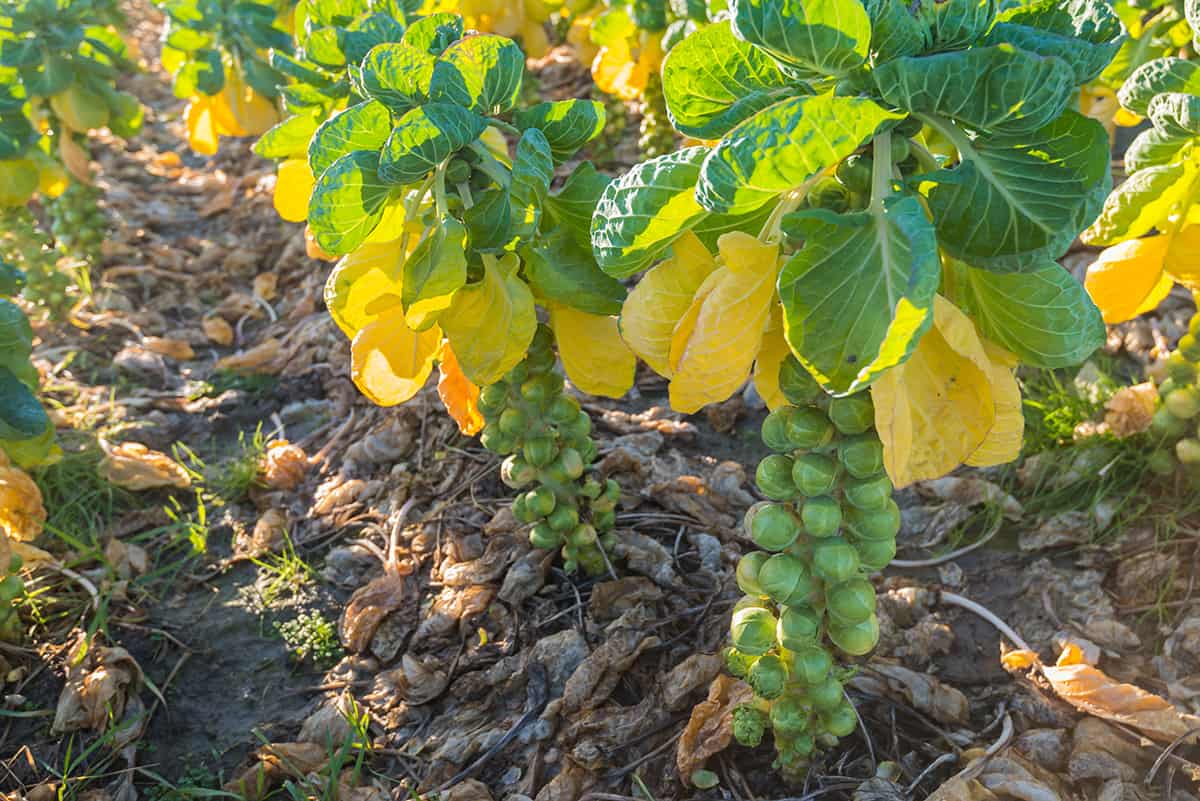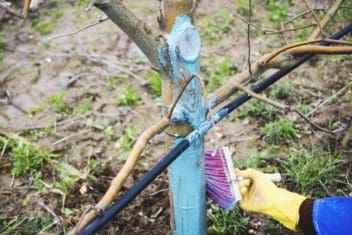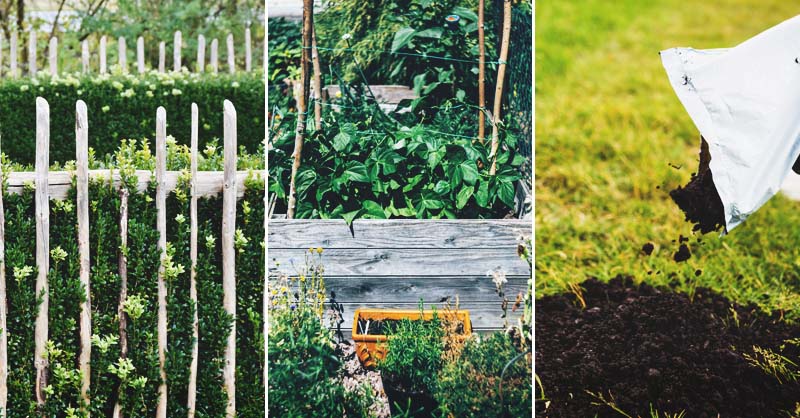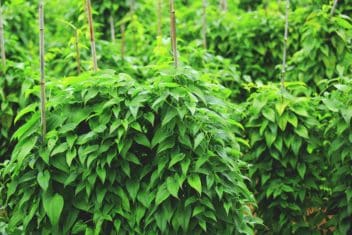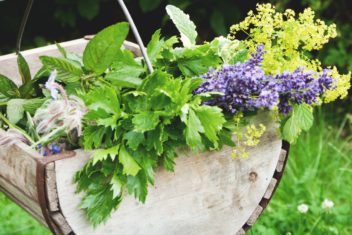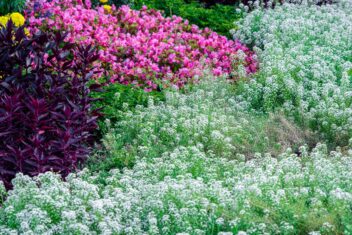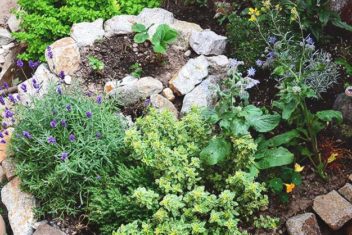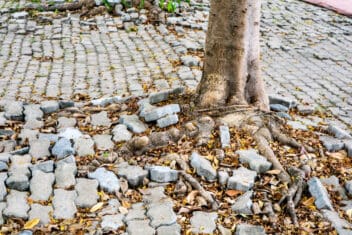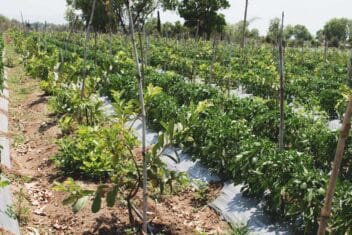Have you ever managed to get a solid crop of Brussels sprouts? If so, you’re in the minority. Many people really struggle with cultivating these plants and aim for easier brassicas like kale, broccoli, and rapini instead. Fortunately, there are solutions to just about all the Brussels sprouts problems you may come across.
Read on to learn about some of the more common issues, and how to sort them out.
1. Failure to Germinate
If your Brussels sprouts haven’t poked their heads out of the soil after a month of seeds being sown, check the growing bed. Cabbage maggots are renowned for tunneling into brassica roots and eating the goodness out of them. Look for slimy roots that may have brown scarred bits or honeycomb patterns on them.
These maggots will mature into cabbage root flies. They love moist soil in early springtime, so try to plan your planting for further along in the season. Warmer temperatures and drier soils help to reduce their numbers. You can also plant mint and alliums like garlic chives or leeks as companions to fend them off.
2. Weak-Looking Plants on Spindly, Wasted Stems
Are your seedlings’ stems brown and wilty, causing the leafy heads to fall over? Then you’re probably dealing with damping-off disease. This is caused by a fungal pathogen that absolutely thrives in cold, wet soil. I’ve had to contend with this numerous times when I’ve planted too early in the springtime.
If you’re starting seeds in flats indoors, make sure that your planting pots have been sterilized. Additionally, only use sterile potting soil mix, and water with warm water. In fact, you can even use a warm, diluted garlic “tea” to water your seedlings. This will kill off the pathogens while keeping your seedlings hydrated.
3. Seedlings are Cut Off at Soil Level
We touched upon cutworms in our article on common corn-growing problems, but they’ll attack all kinds of plants, which is why we have an entire guide dedicated to helping you deal with them.
Basically, these grubs lie just beneath the soil’s surface and gnaw their way through stems. Your plants will end up looking like someone scythed them down right at their bases.
You can fend off the grubs by keeping the area well weeded, and by sprinkling wood ash all around the plants’ bases. Additionally, making cardboard collars for your plants’ stems may help. Cut toilet paper rolls in half crosswise, then again lengthwise, and tape them around the stems. Overlap them for a close fit, and push them down about an inch into the soil to create barriers.
Cover the exposed bits with double-sided tape for extra effectiveness.
4. Early Flowering
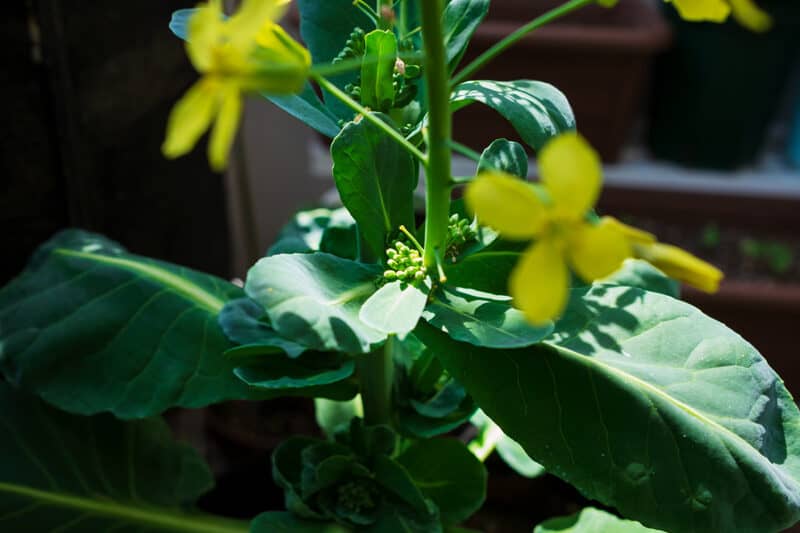
Did you know that brassicas can bolt from the cold as well as the heat? Yuh-huh, they can. Basically, if seedlings are hit by an unexpected cold snap, they think winter is coming. As a result, they’ll panic and try to go to seed as soon as possible, thus completing their reproductive cycle.
Don’t plant seeds more than a week before your area’s expected last frost date. This should prevent sudden chills from annihilating them. You can also cover them with straw mulch to regulate soil temperature. Cold frames and cloches can also provide extra protection if you get a sudden cold weather alert for your area.
5. Dark, Wiry Stems
Have you heard of “wirestem” before? I hadn’t until I noticed that my Brussels sprouts seedlings looked like hairbrush bristles. It’s caused by the same type of fungal pathogen that causes damping-off disease, and will basically prevent your plants from developing.
Plant in warmer, dry soil that drains well. You may have to work extra compost into the soil to ensure sufficient drainage.
6. Black or Purple Spots on Leaves
This is known as “bacterial leaf spot” and it can happen if you water from overhead. Basically, it’s little black or purplish fuzzy spots on the outer leaves. If you notice it early, you can pinch those leaves off and burn them so the infection doesn’t spread.
That said, if you were away for a few days and came back to find your crop blighted, you’ll have to burn the lot. Then treat the soil with garlic water and leave it fallow for a season. Then, don’t plant Brussels sprouts there for a couple of years.
7. Rotted Insides
You won’t find this issue in your sprouts unless you cut them open and find their insides blackened and furry. Sometimes you’ll get a hint as to its presence by V-shaped yellow-green coloration on the outside, but usually you won’t find it until it’s too late.
Burn everything in that area, treat the soil with the aforementioned organic fungicide, and rotate crops.
8. Powdery Coating on Leaves
This was the bane of my pea plants this year, and it’s one of the most common Brussels sprouts problems too. It thrives in warm, humid conditions, and makes your plants look like they’re covered in talcum powder.
This mildew can be avoided by ensuring proper spacing between your plants and never watering from above. Leave enough room for leaves to spread out without overlapping. Additionally, use clean, sterile snips to prune the leaves regularly. If there’s plenty of space for air and sunlight to get to the leaves, they’re less likely to develop mildew.
Also, only water at soil level so there’s no opportunity for extra water to accumulate between leaf nodes.
9. Fuzzy Gray Growth
Although downy mildew and powdery mildew are both humidity-loving pathogens, they manifest differently. They also have slightly different growing preferences. For example, downy mildew prefers cool humidity overheat, and develops on the undersides of leaves rather than on top of them.
If your Brussels sprouts leaves are turning yellow, check their undersides. Look for fuzzy gray “down” and black spots. Should you find them, destroy these plants and apply a garlic fungicide. Then avoid planting brassicas there for at least three years.
10. Ragged Holes in the Leaves

They might be pretty, but these jerks (Pieris rapae) will bounce all over your brassicas if you let them. They’ll lay eggs on the leaves and their larvae will nom their way through all your crops.
Your best bet for keeping them away is to use floating row covers. Aim for light-colored, very fine mesh on supports that are at least 2 feet tall. They’ll allow air and light to flow around your plants, with enough room for them to spread out, but no chance for the butterflies to get close.
*Note: If your area has a lot of issues with cabbage whites, consider planting a “trap crop” for them. For example, I plant huge collard and mustard greens around the periphery of my property. These are sown far enough away from other plants so they don’t cross-pollinate, and capture the butterflies’ attention so they don’t wander inwards.
11. Caterpillars on the Leaves
In addition to the white butterflies mentioned above, other winged critters (such as moths) like to lay their eggs on sprout plants as well. Floating row covers are ideal, but there are other options if you don’t want to go that route.
Do you have chickens or ducks? Then let them wander in your brassica beds. They’ll pick the worms off your plants, and will plump up nicely on these grubs as they go. You can also plant yarrow in the area to attract braconid (parasitic) wasps.
12. Holes in Leaves With Deformed Stems
Welcome to beetle larvae land. Beetle damage is one of the most common Brussels sprouts problems, and there are a number of different species that like to chew on them. Flea beetles and June bugs are two major pests, though several other visitors may stop by for dinner too.
Turn the soil over well before planting to expose larvae so neighborhood birds can eat them. Keep the soil clear of detritus so there’s no place for these bugs to hide. Additionally, you can scatter food-grade diatomaceous earth to destroy them if they try to feast on your plants.
13. Wilting Plants
Clubroot doesn’t sound like much fun, does it? It’s an issue that’s caused by yet another soil-borne pathogen, which deforms brassica roots into misshapen clubs (hence the name). These mangled roots can’t draw moisture or nutrients, so the entire plant dies.
Fortunately, this pathogen only thrives in acidic soils. Test yours, and toss in some extra lime if the pH is under 7.2. If you do find clubroot afflicting your plants, let that bed go fallow for a year, then avoid planting brassicas there for another two years after that.
14. Bolting
One of the main Brussels sprouts problems I’ve dealt with is bolting. Every single crop I started ended up going to seed at their first opportunity. It turns out that, unlike many other heat-tolerant brassicas, these plants are famous for doing really badly if subjected to sudden heat waves.
You can avoid the bolting issue by planting an autumn/winter crop instead. Since Brussels sprouts are biennial, they’ll spend the first year establishing their root structure, and spear upwards in their second year. Time your planting in such a way that their above-ground growth will coincide with cooler weather.
For example, do you live in a place that gets mild winters? If so, aim to start your seeds in mid to late summer. This way, aerial parts will develop around mid-September and be ready to harvest in late autumn.
My zone 4b area gets really cold winters, but ridiculously hot spells in July and early August. I learned that the best thing for me to do was to sow in mid-June. This way, the aerial parts really pop up in early September so I can harvest them in late October to early November.
Of course, success in this regard depends entirely on the weather and its inevitable mood swings. You might experience a freak hailstorm in June or a heatwave in September. As always, gardening is a complete crapshoot, albeit one with our fingers crossed in hope.
15. Death Between Growing Seasons
This can happen in climates with super-cold winters. Even if you mulch your plants well, the severe cold can kill them off at root level.
One way to combat this is to dig up first-year roots, pot them, and overwinter them indoors. You can keep these pots in a dry, temperate basement or attic and then transplant them back outside after the last spring frost.
16. Misshapen Sprouts
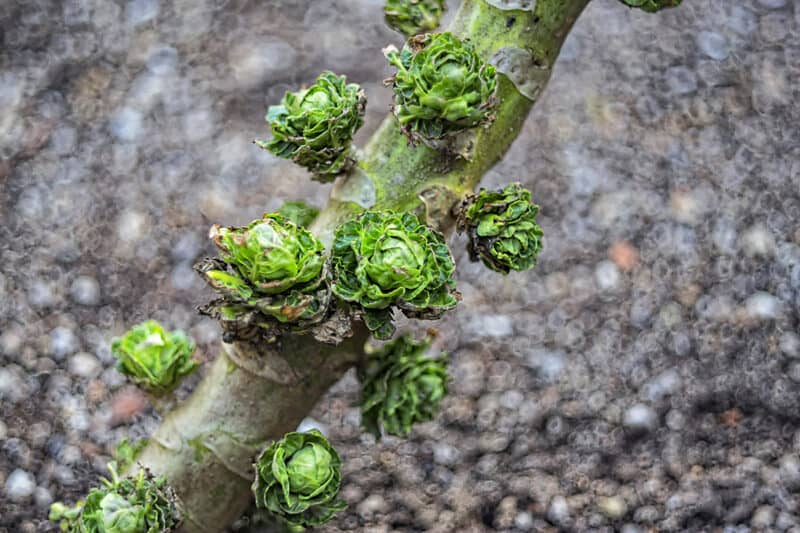
Have your plants developed Frankensprouts? Then chances are you’ve sown them too close to other brassica species and they’ve cross-pollinated. I had this issue one year when I planted my sprouts too close to some Napa cabbage. Yeeeek.
Space out your brassica crops well so they don’t interbreed, unless you’re intentionally trying to create hybrid cultivars. These crops include:
- Brussels sprouts
- Cabbage (European or Asian)
- Broccoli (broccolini, rapini, etc.)
- Cauliflower
- Turnips
- Rutabagas
- Radishes (including wasabi)
- Kale
- Arugula
- Bok Choy
- Tatsoi
- Collard Greens
- Mustard Greens (including mizuna)
Another type of deformity is loose-leafed sprout heads. This can happen when the weather wavers between hot and cool. The sprouts go a bit haywire and don’t know whether to form tightly or loosen up.
17. Brown Leaves
Did you know that Brussels sprouts are prone to boron deficiencies? Stir some Borax (yes, that stuff) into compost tea to give them a nutrient boost. Then make sure to work the same Borax into next year’s compost before amending soil for the following season’s planting.
Remember that these sprouts are heavy feeders. The best soil for them is fairly firm but well-draining, heavy in nitrogen, and low in phosphorous.
18. Tipping Over
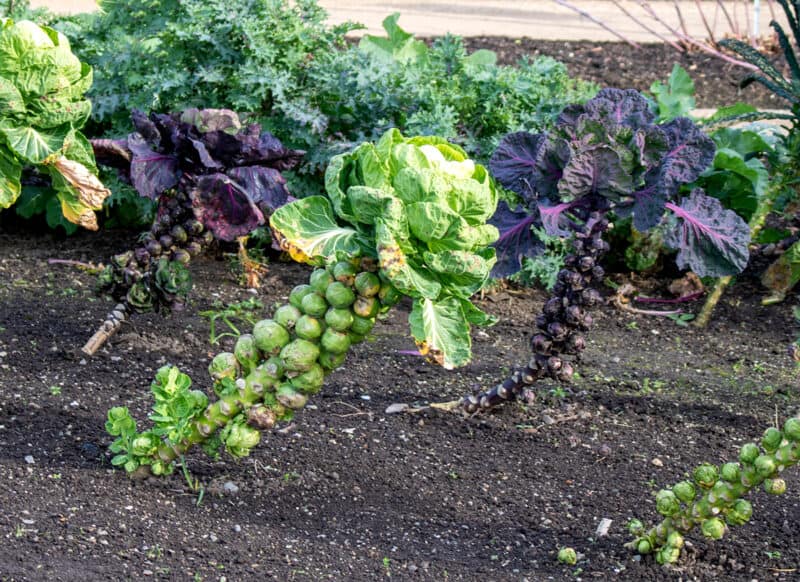
You may have noticed that Brussels sprouts are pretty top-heavy. That makes them prone to tipping over in wind (known as lodging). You can avoid this problem by staking plants, planting shorter cultivars, or heaping about six inches of soil at the base once the stem has matured.
Crowding makes this problem more likely.
Tackle Brussels Sprouts Problems Early for Best Results
You’re undoubtedly keeping a watchful eye on all your plants, and that’s a noble (and monumental) task. For many of the issues mentioned above, quick action can mean the difference between crop success and failure. Although it seems like there are more Brussels sprouts problems than happy stories, you’ll be amazed at how these plants can flourish with proper care.
Amend your soil well, and choose disease-resistant varieties whenever possible for best results. Destroy mildewed plants, avoid watering from above, and you’ll undoubtedly end up with a happy, healthy crop.
Then you’ll just have to find a few hundred new Brussels sprouts recipes to enjoy.
